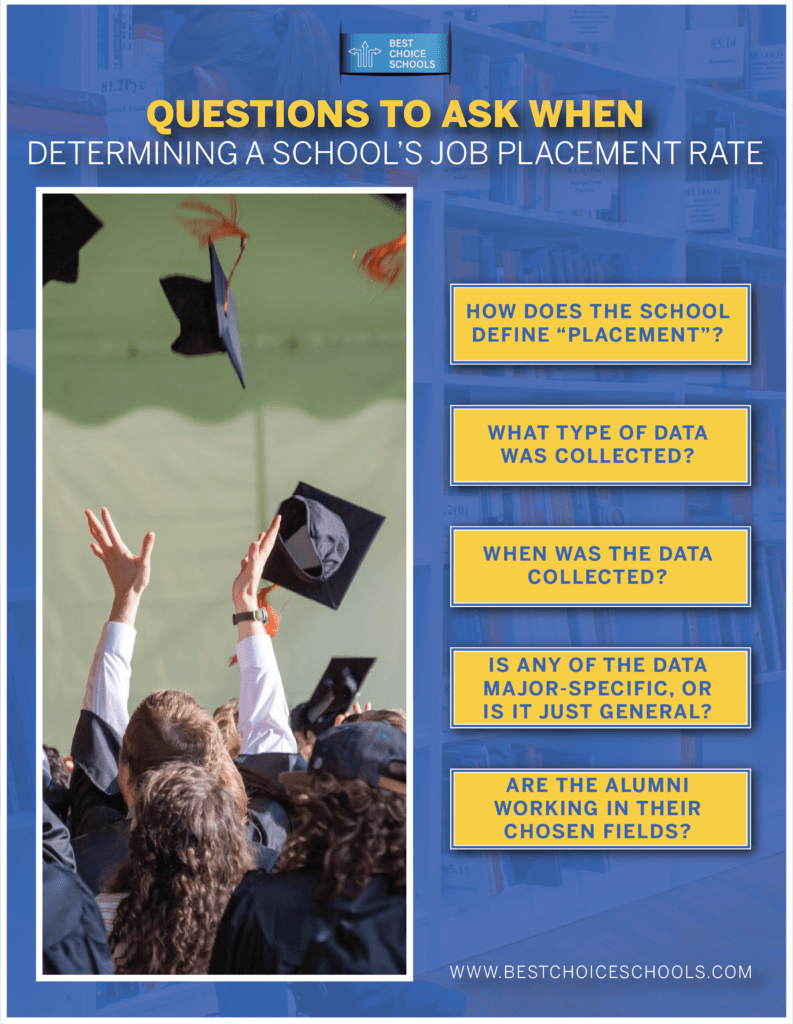
College is a huge decision. There are many factors to consider before picking an institution to attend – how good is the school? Where is it located? What’s the tuition rate? Do they have the right major? How is the dorm situation and cafeteria? Is it a private or public school? What extracurricular activities and sports do they offer?
All of these questions are essential to the incoming freshman. However, another question is just as important and sometimes overlooked – what is the job placement rate at the college?
Job placement in college can be difficult, especially in a fluctuating economy. If you get a college degree, you want it to be worth your time. Almost every university has a career counseling and job placement program, but finding job placement rates for colleges can be challenging. So how exactly do you find a job placement rate for a college?
Table of Contents
How to Find a Job Placement Rate
To find the job placement rates for higher education or a specific college, talk to the admissions office or career counseling center. Make sure to ask some follow-up questions about their published rate, as several factors could change the official number.
The federal government requires colleges and universities to provide potential students with job and graduate education placement information. Schools are also mandated to report credit transfer policies, textbook prices, and graduation rates of lower-income students, but these can be extremely difficult to find as well.
A job placement rate is generally defined as the percentage of graduates who are employed after leaving college. However, there are no specific rules for measuring this, so the numbers can vary widely from what’s published or advertised by the college. If you want to find out the actual job placement rates at college, you’ll have to do it yourself.
Finding a Placement Rate By School
Every school is different, and their success rates in employed graduates vary as well. Unfortunately, there’s not much regulation for what colleges do share and virtually no auditing their numbers. This lack of accountability means that the published job placement rate is not always accurate.
Although it should be easy to find (mainly because it’s a legal requirement), an accurate job placement rate is often challenging to see on your own. In many cases, you’ll have to contact the school directly and hope they have more information on their graduated students.
However, if you know what you’re looking for, you might be able to find more precise details on actual job placement. It greatly depends on how much effort the college puts into finding out these statistics. Some schools are more transparent than others on this, but you’ll still have to contact a school official and ask some specific questions.
Search the Internet
As with most information, the internet is the first place to look and the last place to trust. Start with a web search to give yourself a baseline. However, you’ll need to prepare yourself for a deeper examination if you want a proper understanding of job placement rates.
Many websites provide data for the top schools’ placement rates, whether for grad school or employment. Even if the school you’re looking for isn’t on these lists, there will be a number available somewhere. Write that number down and remember it – you’re going to dissect it thoroughly later.
If you are looking at a state college, you might be in luck. A few states are beginning to share labor statistics for all public universities, which is a step towards transparency. Check the state government website for any college information.
Find Information on the School Website
Some universities have the job placement rates available on their websites (especially if they’re high rates). However, you can’t entirely depend on their methods of gathering this data. Schools rarely have a thorough process of finding their graduates’ employment rates.
Many schools use post-graduate surveys to provide job placement data. However, these are primarily unregulated and skewed to the students who complete the surveys. Students with high success rates and careers are much more likely to fill out a job placement survey.
Some schools don’t post numbers at all or supplement frustratingly insufficient data with alumni success stories. Remember, every university is required to share these statistics, even if they’re inaccurate. If you can’t find the data with a general search or on their website, you can add the general number to your list of questions to ask.
Ask a College Employee
Now that you know what the “official” job placement rate is, it’s time to start digging deeper. To do this, you’ll need to contact an admissions counselor or career counselor. While these officials might not know the exact answers, they will know where to look for them.
If you’re looking to apply to a college, an admissions counselor should be equipped to help you find the information. For currently enrolled students, you can speak to your advisor or book a session with career counseling. Colleges created career counseling for higher job placement, which makes that office a great resource.
Generally, you can find the career counseling or admissions counseling contact information on the official college website. Then, you can call the office, set up an appointment, or send your questions via email. While you’re likely to get thorough answers over email, an in-person meeting can help you see the college’s methods of finding the information.
Define the Job Placement Rate
Once you have the basic information, it’s time to dig deep and see if it’s accurate. The best way to do this is to keep in touch with your admissions counselor or career advisor to ask some follow-up questions. Whether you email, call, or meet in person, it’s vital to know what questions to ask.
Although colleges don’t get audited for their information sources, very few colleges make up a number. Instead, most have some sort of aggregated data that they pull from – a survey, a poll, or reports from alumni. Unfortunately, however, this information is usually woefully inaccurate because of its incompleteness.

What Does “Placement” Mean?
To get a clearer picture of what a college’s job placement rate even means, ask what they refer to when they say “placement.” Some colleges include graduate school or volunteer work in this data, which can skew the numbers for employment rates.
If the college includes grad school information with their job placement rates, ask if they can give you specific numbers on how many alumni go to grad school instead of employment. This answer should narrow down the rate and give you a more accurate picture.
What Date Was Collected?
The next question to ask is what kind of data is collected by the college. How do they get the numbers they are showing prospective students? Many schools use post-graduate surveys to collect information. However, while the data in these surveys might be accurate, it isn’t complete.
Some colleges collect data more rigorously, matching former students’ information with LinkedIn profiles or company websites. Unfortunately, these are rare cases. It’s more likely that a college ran a quick survey or reached out to alumni with no guarantee of response.
When Was the Data Collected?
Post-graduate surveys and data collection varies in timing. For example, some colleges collect data immediately after graduation, but most wait ninety days, six months, or even a year to follow up on students’ employment information.
Ask the college when they send out their surveys or look for data. Also, ask them how many students utilize career services or get jobs from the on-campus job fairs. Colleges with these resources are more likely to increase the job placement rate.
Is There Major-Specific Data?
To get even more specific, ask the previous two questions concerning your planned major. If the school has sent out polls or surveys to graduates from each major, the data will vary widely. Larger majors might be more accurate than a field of study with only a few graduates.
If there is major-specific data, the college will most likely have the numbers on graduates and employment for your major. As with the overall numbers, this information might be largely positive, but you need to know what percentage of former students responded with data.
Are the Employed Alumni Working in Their Field?
When you’re deciding on a major, you have to know what your job opportunities are. While colleges will tell you that many of their alumni are employed, they might not be as forthcoming with the students that didn’t get jobs within their major. For example, many students graduate and settle for jobs they don’t love because the market isn’t conducive to their specific field of study.
When you’re talking to the guidance counselor, ask them this specific question. This is especially helpful if you’re planning on majoring in liberal arts of any kind. Although it’s great to be flexible with your education, it’s ideal to have a job within your major. You deserve to know the general odds of that happening for you.
See also: 10 Tips for Choosing the Best College Major
Talk to Alumni
Those are the steps for finding out as specific data as you can on the job placement rate for a particular college. However, the data is not the only factor affecting job placement after college. For a practical side, you can reach out to recent alumni in your prospective major and get their input on the school and careers after graduation.
If you are looking into a college, the people who know it best are its alumni. They lived and learned at the school for four years and have hands-on experience with student activities, classes, and what life looks like after graduation. For a more general overview of how easy or complicated the post-graduation job search is, alumni can be a great resource.
You can ask a college graduate what they know about the employment rate but understand that it will primarily be anecdotal evidence. Alumni can tell you about their personal experiences and the experiences of their classmates but won’t be able to give you data. However, their practical tips can be beneficial when it comes to navigating college and future employment.
Finding a Placement Rate By Major
Of course, not everyone has decided on a college when they know what they want to do with their lives. If you’re sure about your major, congratulations! That’s a tough decision to make and can be stressful for undecided students.
If you know what you what to study but haven’t decided on the college yet, we highly recommend looking into colleges known for programs you are interested in. Then, if you want to know what the average job placement and salary are for a specific occupation, it will be easier to drill down to that information.
Unlike college job placement statistics, general placement rates are easy to find. While they won’t apply to specific colleges, you’ll be able to see the overall rate of employment for your chosen field. This information can be helpful if you’re still unsure or deciding between two different occupations.
Look at the Department of Labor Statistics
The Department of Labor lists average salaries and unemployment rates for many different occupations. So it’s easy to look up your dream job and see whether the market is over or undersaturated with workers.
You can also look at the median income, how income is affected by college education, and where the information comes from. Although it’s not related to any specific college, the Department of Labor might help you decide on a major or switch to a school that will help you get a job in a particular area.
Search the Internet
Of course, there’s more to a job than its availability and salary. Quality of life depends very much on benefits, company atmosphere, and location of an occupation. Most majors will give you a relatively large scope, but it’s essential to find out what job is most likely to be available to you.
If you have settled on a particular major that only applies to one career, you should know the odds of getting a job in that area. The more general your major is, however, the more likely you will be able to shape your experiences to a broader assortment of employment opportunities. You can find the public job placement rates and positions per major on the web.
Related: Are College Rankings Useful?
Final Thoughts
Although you might not find the exact data for the college you’re looking at, these steps will help you see a more accurate picture. Unfortunately, many schools have gotten away with not giving out the correct information. However, if you know what you’re looking for, you can look past the flaws in their system and find the actual job placement rate.
Universities typically won’t post outright lies about their placement rates, but they may fudge the data a bit to make your post-graduation prospects sound more promising. Searching for the rate isn’t difficult, but you’ll need to consider other factors as well. When you find the job placement rate, just remember to keep this figure in its appropriate context in order to make a sound decision about the college that you choose.
You may also like:


